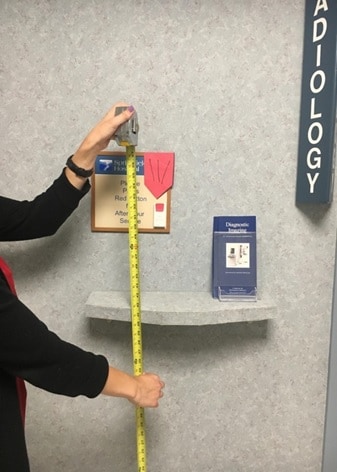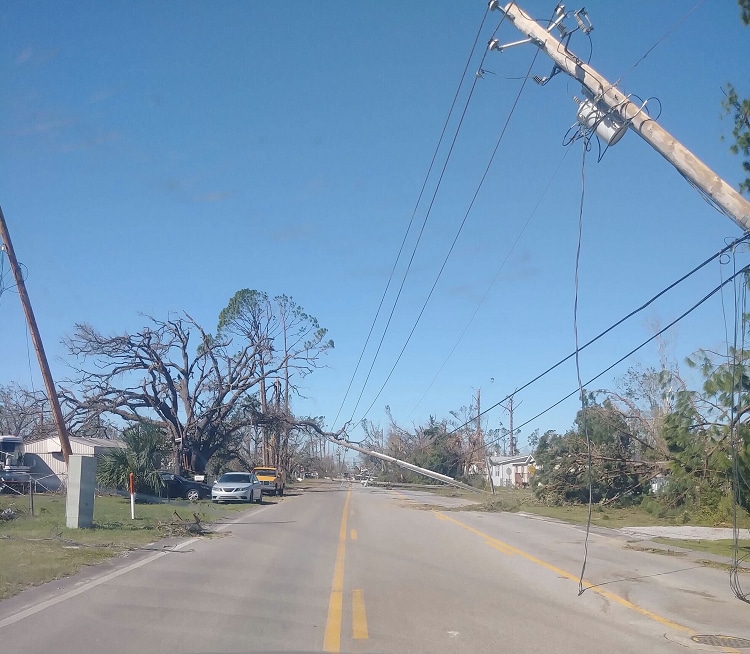Meeting the Needs of Special Populations

Sign height is measured at a mammography clinic in Vermont.
Award recipients in CDC’s National Breast and Cervical Cancer Early Detection Program have found many innovative ways to help those in need of cancer screening get the tests they need. Below, we share highlights from some programs that reached out to groups experiencing disadvantage including racial and ethnic minorities, people with disabilities, and victims of a natural disaster.
Vermont Clinics Become More Accessible
Patients with disabilities are less likely than the general population to be current on their cancer screenings. Staff in You First, Vermont’s cancer program, set out to reduce the barriers to patients with disabilities. They used a survey to assess 14 of the state’s 16 mammography clinics for barriers faced by patients in wheelchairs and those with limited vision or developmental disabilities. Barriers found included—
- Lack of accessible parking spaces.
- Waiting room seating arrangements that did not allow room for wheelchairs.
- Directional signs that were hard to see or read, did not include Braille lettering, or were not mounted at the correct height or location.
- Changing rooms that were too small for a wheelchair.
- Doors that were hard to open.
Each clinic received a report that listed its strengths and problems, and recommended ways to improve their facility. The University of Vermont Medical Center, which provides the most mammograms in the state, agreed to improve the accessibility in three of its facilities. These changes will help all patients who use mammography clinics in Vermont.
Oregon Community Health Workers Link African American Women to Cancer Screening Resources
Between April and December 2019, community health workers in the Urban League of Portland identified women who needed to be screened for breast and cervical cancer. They provided culturally sensitive education about risk factors, family history, genetic counseling, and healthy choices. The Urban League’s “I Pledge” campaign asked African American women to pledge to get a mammogram. Every week in October, a woman who had made the pledge was featured on their website.
The community health workers linked women to resources provided by the Oregon ScreenWise Program, including health fairs and mobile mammography events. As a result, women received the cancer screening and treatment they needed.
“I went for my first mammogram through the free mobile mammogram program through the Urban League of Portland. I was nervous to go and wasn’t sure what to expect. However, as soon as I checked in, everyone was so warm and friendly that I felt very comfortable and at ease. They made the process really easy and I left feeling so happy I had gone. I so appreciate this kind of care doing something that’s so vulnerable and emotional.”
Breaking Down Barriers to Breast Cancer Screening in Iowa’s Amish Community
People in Amish communities often have trouble making and keeping appointments for cancer screening because they don’t have telephones, automobiles, or other technology. But they can use public phone booths on a limited basis.
A community health worker contracted with the Iowa Department of Public Health focused on communities that have many Amish people. In August 2019, the health worker placed flyers that promote cancer screening in businesses and phone booths in these communities. The flyers listed the Care for Yourself program name and the Black Hawk County Health Department’s phone number on a tear-off tab. Women who called were navigated to a free mammogram night hosted by a local hospital.
Within one month of posting these flyers, three Amish women who had seen the flyer were enrolled in the Care for Yourself program and were screened for breast cancer. The community health worker plans to continue a close partnership with the local medical center to offer more free mammogram nights. She also shared her practices with other community health workers in the program to help reach other Amish communities.
Alaska Program Creates Breast Health Education Aid for Women with Learning Disabilities
Women with learning disabilities are less likely overall to get a mammogram because they may not know how to get one or why it’s important. Only 56% of women with learning disabilities in Alaska have been screened for breast cancer, compared to 71% of women without learning disabilities.
The Ladies First Program found a health education aid in use in the United Kingdom that has few words, many pictures, clear language, and a simple layout. During late 2018 and early 2019, the program adapted it for use by women with learning disabilities. The program hired a photographer to take new, culturally appropriate pictures, and worked with women in this community to create a breast care booklet and caregiver guide that they would find useful.
The Ladies First Program printed the booklets and handed them out at events of interest to women of the intended audience, and at conferences on aging and disability. The program also shared them electronically with more than 550 people and groups. Partners said the booklets helped them to talk about breast health with women with learning disabilities. Ladies First learned that the booklet is also a good resource for older adults, people with low health literacy, people who speak languages other than English, and providers and resource workers who work with these groups.
Culturally Tailored and Integrated Health Services Increase Cancer Screenings
American Indian and Alaska Native women are more likely to die from breast and cervical cancers than other women because their cancers are often advanced when they are found. About two-thirds of Native women live in cities, where few culturally appropriate cancer screening services are available. The Native American Rehabilitation Association of the Northwest’s Women’s Wellness Program was able to get many of these women screened for cancer once, but had trouble bringing them back for follow-up visits following an abnormal screening test finding.
Through in-depth interviews with women enrolled in the program, staff learned why many women didn’t come back. Some reasons included mistrust of the health care system, lack of transportation, and the need to care for family members. Knowing this, in 2019, the Women’s Wellness Program found new ways to help women get the follow-up care they needed. For example, they offered colposcopies at the clinic, created culturally tailored educational materials, and provided patient navigation. They also began offering mobile mammography and other services at their Saturday clinic for diabetes care.
The percentage of women completing breast and cervical cancer diagnostic follow-up went up from 74% to 85%, and more than 90% completed breast cancer diagnostic follow-up. Culturally appropriate patient navigation has also helped lower the number of patients who don’t come in for their appointment.
Program Helps Kansas Women After Release from Jail
More than 200,000 women are diagnosed with breast cancer each year, and women who are incarcerated face unique risks associated with poor access to health care. Many women who are in jail in Kansas are not up to date with their mammograms when they are released. To address this need, the Kansas Breast and Cervical Early Detection Works Program invited community health workers from Grace Med to provide educational seminars about the importance of cancer screening and help enroll women in the program.
Almost all of the women who attended the seminars, which were held November 2018 through May 2019, said they learned about free screening. One woman said, “Everything she [the speaker] talked about was new to me.” Four out of every five attendees now plan to get mammograms regularly.
The Shawnee County Department of Corrections added cancer screening to the list of tasks women need to do when they are released. The Early Detection Works Program will send them cancer screening reminders, provide patient navigation services to help them get screening and diagnostic tests if needed, and find them a primary care doctor so they can manage their health.
Patients Get Health Care on Time Despite a Natural Disaster in Florida

Cancer screening results continued to be delivered to patients, even in the midst of a natural disaster.
On October 10, 2018, Hurricane Michael hit all nine counties in the Florida Breast and Cervical Cancer Program’s Jackson region. The counties lost electricity—some for more than a month—and cellular services were down for a week. Many people’s homes, businesses, and cars were damaged. The buildings and mammography machines at the main radiology facility had severe damage, making it impossible for patients to get a mammogram. Also, results could not be obtained for biopsies done before the hurricane hit. Many patients missed their appointments.
To cope with the disaster, program staff secured a private telephone line at a local hospital so they could provide test results to doctors. They offered gas cards to patients to offset the cost of traveling to clinics in other counties and helped patients with abnormal follow-up test results apply for treatment through Medicaid. As a result, many patients received care on time, including two women who needed breast cancer treatment.